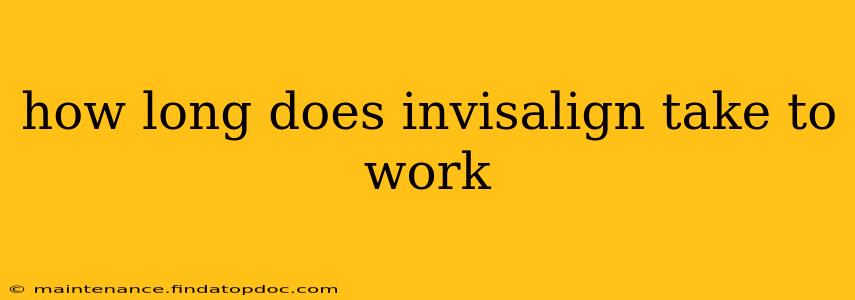Invisalign, the clear aligner system, offers a discreet way to straighten teeth. But a common question lingers: how long does it actually take? The answer, unfortunately, isn't a simple number. Treatment time varies considerably depending on several factors. This comprehensive guide delves into the specifics, providing you with a realistic understanding of what to expect.
What Factors Influence Invisalign Treatment Time?
Several key factors determine the duration of your Invisalign journey. These include:
-
Severity of Misalignment: Minor crowding or spacing will naturally require less time to correct than significant overbites, underbites, or crossbites. More complex cases necessitate more aligners and a longer overall treatment period.
-
Individual Response to Treatment: Each person's teeth respond differently to the gentle pressure applied by the aligners. Some individuals see faster progress than others.
-
Compliance with Treatment Plan: Wearing your aligners for the recommended 20-22 hours per day is crucial. Inconsistent wear significantly prolongs treatment time.
-
Age: Younger patients often experience faster tooth movement compared to adults. Bone density and the body's natural remodeling processes play a role here.
How Long Does Invisalign Typically Take?
While there's no one-size-fits-all answer, the average Invisalign treatment time ranges from 12 to 18 months. However, it's essential to remember that this is just an average. Some individuals may complete treatment in as little as 6 months, while others may require 24 months or longer.
What if My Treatment Takes Longer Than Expected?
Longer treatment times aren't necessarily a cause for concern. Your orthodontist will monitor your progress closely and make adjustments as needed. Factors like unexpected tooth movement or the need for refinements might extend the timeframe. Open communication with your orthodontist is key throughout the process.
Can I Speed Up My Invisalign Treatment?
While you can't drastically accelerate the natural process of tooth movement, you can optimize your treatment by:
-
Strictly adhering to the recommended wear time: This is the single most significant factor in treatment success and speed.
-
Attending all scheduled appointments: Regular check-ups allow your orthodontist to monitor progress and make any necessary adjustments.
-
Following all aftercare instructions: Proper oral hygiene and care for your aligners help prevent complications that could delay treatment.
What Happens After Invisalign Treatment?
Once your active treatment is complete, your orthodontist will likely recommend a retention phase. This typically involves wearing retainers to maintain the newly straightened position of your teeth. The length of the retention phase varies but is crucial to prevent relapse.
How Much Does Invisalign Cost?
The cost of Invisalign varies depending on several factors, including the complexity of your case and your geographical location. It's best to consult with your orthodontist for a personalized cost estimate.
What Are the Alternatives to Invisalign?
Traditional metal braces remain a popular option for teeth straightening. While less discreet, they can often provide similar results and may be suitable for more complex cases. Other clear aligner systems, similar to Invisalign, are also available, offering alternative treatment options.
Is Invisalign Right for Me?
The suitability of Invisalign depends on the specific characteristics of your teeth and your overall oral health. A consultation with an orthodontist is crucial to determine if Invisalign is the appropriate treatment for your individual needs. They can assess your case and determine the most effective course of action.
This information is for general knowledge and doesn't constitute medical advice. Always consult with a qualified orthodontist to discuss your specific needs and concerns regarding Invisalign treatment.
